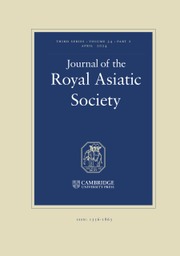No CrossRef data available.
Article contents
The Date of Jāmī's Silsilat al-dhahab
Published online by Cambridge University Press: 15 March 2011
Extract
The date of the composition of Jāmī's “Chain of Gold” is usually given, for instance, by E. G. Browne in his Literary History of Persia, iii, p. 516, as a.h. 890. This is certainly the date of the second of its three daftar, for the poet states the fact plainly in its penultimate bayt, and the addition of 890 in figures in a few MSS., notably the famous Leningrad autograph, Rosen No. 80, adds nothing to this evidence. In very few MSS., however, to judge from the many catalogues which I have searched, is there any other indication of the date of any part of the poem, but I have found descriptions of two, which contain matter conflicting with the extension to the first daftar of the date of the second. The more important is No. 185 in vol. ii of the Catalogue of the Oriental Public Library at Bankipore (Patna, Bihar), published in 1910. This volume is missing from the two Cambridge copies of the Catalogue, but Dr. L. D. Barnett has kindly transcribed the entry for me from the copy in the Library of the School of Oriental and African Studies. It runs as follows: “No. 185. Silsilat al-dhahab, daftar 1, and minor lyrical poems, supposed to be in the author's own hand. MS. not dated but contains note and chronograms on birth of Jāmī's son, Shauwal 9, 882.” The Secretary and Librarian of the Oriental Public Library, Khan Saheb K. Hassan, has since called my attention to an article by Mr. M. Mahfuz-ul Haq in Islamic Culture, i, 1927, pp. 608 ff., entitled “Jami and his Autographs”.
- Type
- Articles
- Information
- Copyright
- Copyright © The Royal Asiatic Society 1945
References
1 I am deeply indebted to my teacher, Professor V. Minorsky, who read and corrected the first draft of this article in manuscript, and also transcribed and translated the colophons. It may be useful to some future editor of Jāmī to know that I also possess a copy of his Khamsa, in which the copying of Tuḥfat al-aḥrār is dated a.h. 893 and that of Khiradnāma-i-Sikandarī a.h. 898, and also a very, early copy of his Shawāhid al-nubuwwat, and that my son G. H. Robertson possesses a very early copy of the Bahāristān: the two last are not dated, but the hand of each is almost identical with that of the Leningrad and Bankipore autographs.


